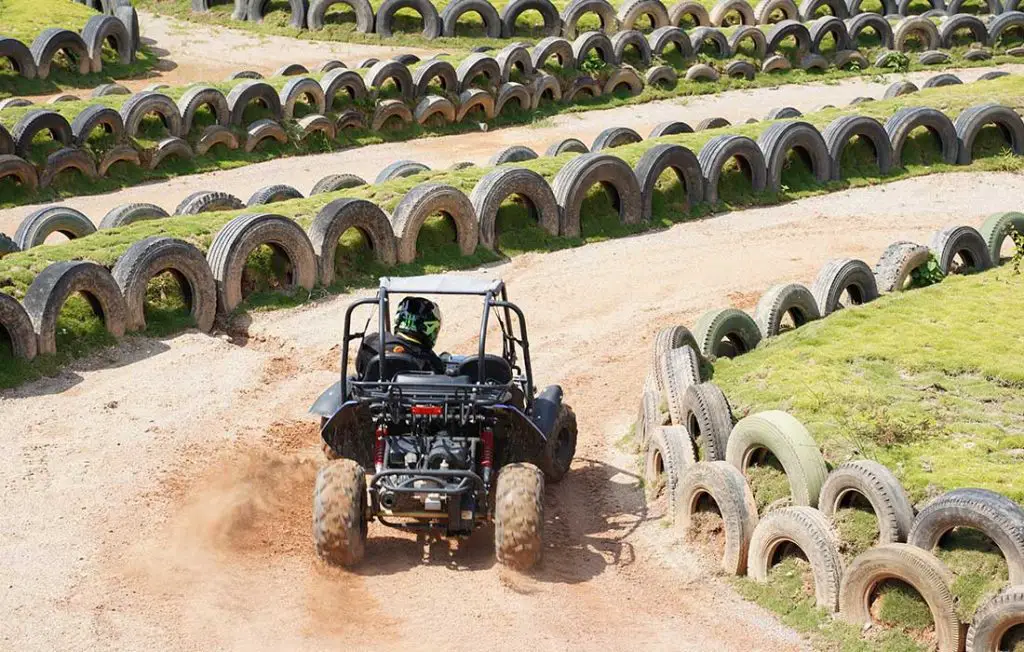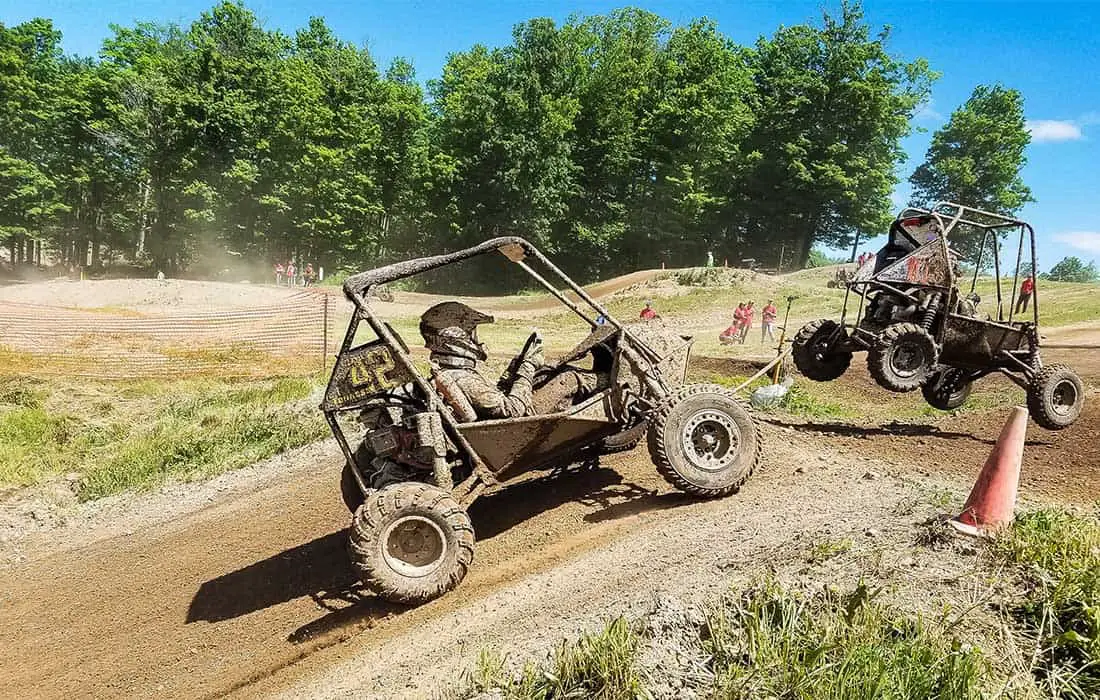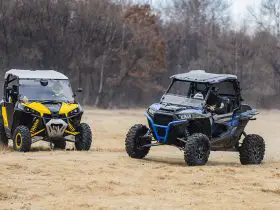UTVs are fun, so it’s no surprise that young drivers and even kids are excited to drive them. However, the full-sized UTVs aren’t exactly designed to accommodate children and youths, and so many brands have released the scaled-down youth UTV models so our youngsters can handle them safely.
Obviously, these Kids UTVs are smaller than the full-size UTV to accommodate the kids’ body sizes. However, the compact size is not the only difference between these smaller models with the full-size UTVs, as we will discuss below.
In this guide, we will discuss all you need to know about Youth UTV or Kids UTV. Here we won’t specifically discuss products, but this will be an informative article on how you should choose between different Youth UTV models, the differences to Youth ATV, and more.
Let us begin.
Table of Contents
What Actually Is UTV?
Let us start at the very beginning. What actually is a UTV?
UTV is an abbreviation for Utility Terrain Vehicle (although sometimes also called Utility Task Vehicle) and is technically a type of vehicle that meets one of the two standards published by ANSI (American National Standards Institute):
ANSI/OPEI B71.9-2016, standards for MOHUV (multipurpose off-highway utility vehicles) or utility UTV, and the vehicle must:
- Have four or more wheels
- Intended to transport persons and cargo
- Non-straddle seat
- Controlled by pedals and steering wheels
- Top speed of at least 40.2 km/h or 25 mph
- Maximum of 2,030 mm or 80” in overall width
- No more than 1,814 kg (4,000 lbs) in gross vehicle weight rating (GVWR)
- Minimum cargo capacity of 159 kg or 350 lbs
ANSI/ROHVA 1-2016, standards for recreational off-highway vehicles (ROV) or recreational UTV:
- Have four or more wheels
- Intended to transport persons and cargo
- Non-straddle seat
- Controlled by pedals and steering wheels
- Top speed of at least 48 km/h or 30 mph
- Maximum of 2,030 mm or 80” in overall width
- No more than 1,700 kg (3,750 lbs) in gross vehicle weight rating (GVWR)
- Equal or less than 1,000 cc
Most UTVs has at least two front seats, and so they are often called “side-by-sides” or SXS. There is also a category with single seat UTV, mostly sport UTVs. You may also see UTVs that are marketed as a MOHUV or ROV (as discussed above).

Specifications For Youth UTV
Now that we’ve discussed the definition of UTV, what kind of UTVs can be categorized as a Youth UTV or Kids UTV?
In general, the Kids UTV is a more compact version of recreational UTV or ROV, so refer to the specification for ANSI/ROHVA 1-2016 as discussed above.
Typically, the Youth UTV is:
- If fuel-powered has between 150cc to 250cc of engine displacement (typically 150cc, 170cc, 200cc or 250cc), and definitely below 500xx.
- Mostly 2WD, although there are premium 4WD models
- Below 100” (2,540 mm) in length
- Below 50” (1,270mm) in width
- Below 70” (1,778 mm) in height
- Low ground clearance below 10” (254mm) and typically below 8” (203 mm)
- Tire sizes can vary, but 22 x7-10 for the front tire and 22 x10-10 for rear tire are common
Related reading: Best electric kids ATVs under $500
Safety Features for Youth/Kids UTV

Safety is obviously a very important concern for youth ATVs since even a 150CC youth ATC can generate a substantial amount of speed.
With various advancements in technology, however, there are now various safety features that might be implemented in a youth UTV so parents can have more control over the vehicle and prevent unwanted accidents.
Polaris, for instance, offers various safety features on their youth UTV models, such as:
- Geofencing
Basically, you can set ride boundaries around your property (or wherever the youth UTV will be operated). You can set speed limits for outside and inside the geofenced area. For example, you can set so that the vehicle can only be operated within a 100’ x 100’ area surrounding your house, and if your kid strays outside this geofenced area, you can limit the UTV’s speed to, for example, 3 mph until the vehicle is back within the geofenced zone.
- Passcode Protection
You can “lock” the vehicle with an app on your phone, so you will need to enter the passcode on the app before the engine can start. By enabling this feature, you can have more control over when the vehicle can be operated. If the youth UTV is currently used, you can restart the vehicle without needing to re-enter the passcode by setting up a time limit.
- Speed Limiting
Pretty self-explanatory, you can use the app (in this case, Polaris’s Ride Command app) to set max speed. You can easily adjust the speed limit when your child is getting better at riding the vehicle or when they are using the vehicle on different terrain.
How Old Must My Child Be To Drive a UTV?
It’s important to note that many states in the U.S. don’t really have a registration category for UTVs, and your UTV (much less Kids UTV) won’t fit the legal definition of an ATV.
So, check your state’s regulations on whether you can use the Kids UTV on public land and the required age limit. You can obviously use the Kids UTV on private land where there are no restrictions.
Different manufacturers might set different age limits on their guidelines, but most of them usually put age 10 years or older.
Safety Equipment and Guidelines for Youth UTV
Make sure your kid is using the following equipment as they ride the Youth UTV:
- Eye protection: no, sunglasses are not appropriate alternatives to goggles. Try to find one with hard-coated polycarbonate lenses that are scratch-resistant.
- Helmet: should fit your kid’s head snugly and fasten securely. Make sure the kid can see clearly, including peripheral vision.
- Appropriate footwear: mainly ankle-length boots or lightweight hiking boots for summer
- Gloves: off-road gloves to prevent bruising from flying gravel and impact. Good pair of gloves can also absorb vibrations from the handlebars for a more comfortable ride
- Pants and long-sleeved shirts: make sure the fabric is light enough with appropriate tear resistance
And in general, here are some tips and tricks to ensure your kids’ safety during their UTV ride:
- Must have adult supervision at all times, or at least via app and technologies as discussed above
- In general, look for Youth UTV that offers adjustable seats and speed-limiting features. Not only these will provide more safety, but you can get more years out of the UTV, making it a better long-term investment
- Make sure the driver (and the passenger if there’s more than one seat) can properly reach the floor with their feet while comfortably holding the handles.
- Pay attention to the max weight limits, and make sure your kid (and the total cargo weight) does not exceed this number.
- Make sure the youth UTV has an appropriate seat belt. If necessary, upgrade to a five-point seat belt
Youth UTV VS Youth ATV
As we know, an ATV (All-Terrain Vehicle) or the “quad” is much smaller than a standard UTV, and the Youth ATVs are also much smaller than the youth UTV counterpart and is designed for smaller children of 6 years old and above.
Although a youth ATV is smaller and is often better for tighter spaces, it tends to be more physically demanding for your kid as they need to always maintain their body balance for optimal control. Also, if you have more than one child, a youth UTV is the better choice since many brands offer side-by-side seating arrangement and can carry multiple passengers.
In general, there are three main factors to consider when choosing between a Kids UTV or ATV:
- Your kid’s age: Some states allow a 6-year old on a 50cc youth ATV, and in most states in the U.S., the legal age for UTV starts at 10 years old. Keep in mind, however, that riding an ATV can be very demanding for the child’s body, so make sure the kid is already strong enough to maneuver the ATV especially when turning.
- Style preference: Pretty self-explanatory. You and your kid might prefer UTV over ATV, or the other way around. If you’ve previously taken the child on the passenger seat if your UTV, then they will have a better idea of driving a youth UTV.
- Safety reasons: A youth UTV is generally safer with the seat belt and roll cage structure. Also, ATVs feature a higher center of gravity which can mean a higher risk of rolling. In general, a youth UTV is a safer choice for your children.
Conclusion
A youth UTV or Kids UTV isn’t only a smaller version of your full-size UTV but is also built with more safety features to ensure the safest possible ride for your kids. In general, you should look for a youth UTV with the best safety features and design approaches according to your budget range.
A mid-end youth UTV can cost, on average, between $3,000 and $5,000, so you’d also want to make sure that the kid can get more years with the UTV, making it a better overall investment. Look for adjustable seats and high enough weight limits so your kid can use the youth UTV for at least several years in the future.










